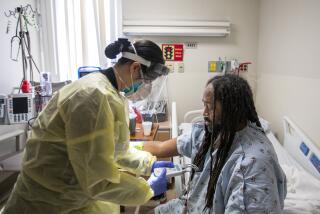Rules Issued to Protect Health Care Workers : Medicine: U.S. regulations seek to safeguard employees from AIDS and other viruses. They stress infection control procedures.
- Share via
WASHINGTON — The federal government Monday announced regulations designed to protect the estimated 5.6 million health care workers who may be exposed on the job to blood and other substances that may carry dangerous organisms, such as the AIDS and hepatitis B viruses.
“It is vital to protect workers who put their lives on the line . . . from the risks . . . they encounter during their work,” said Gerard F. Scannell, assistant secretary of labor for occupational safety and health. “We regard this . . . as a major step forward in providing occupational health protection.”
The regulations, issued by the Labor Department’s Occupational Safety and Health Administration, put full legal force behind standard infection control procedures, known as universal precautions, which thus far have been voluntary. They cover all facilities, such as hospitals and nursing homes, and even individual practices.
The rules also cover other occupations in which workers might be exposed to contaminated substances, such as funeral and linen services, emergency response, prisons, law enforcement and medical equipment repair.
The standards will protect all employees “who could reasonably be expected to come into contact with human blood or other potentially infectious materials in the course of their work,” Scannell told a press conference.
The rules require employers to provide, at their own expense, voluntary vaccinations against hepatitis B, considered the greatest health risk for such workers. An estimated 5,900 to 7,400 cases of occupational hepatitis infection occur each year, Scannell said.
Employees who choose not to be vaccinated must sign waivers, and may be vaccinated later if they change their minds, OSHA said.
The regulations also require employers to institute engineering controls, such as puncture-resistant containers for used needles, and protective equipment, such as gowns, gloves and masks. They also require employers to enforce certain work practices, such as hand washing, to reduce risk.
The new standards require appropriate labels and training workers to make them aware of the risks posed by blood-borne organisms. Facilities that use concentrated viruses will be required to post warnings. Employers will be required to keep records of incidents of exposure, post-exposure follow-up, hepatitis B vaccinations and employee training.
OSHA officials predicted that the rules, effective in March, will prevent more than 200 deaths and 9,200 cases of blood-borne infection every year. There have been 46 cases of occupational transmission of the human immunodeficiency virus, which causes AIDS, since 1981.
“Occupational transmission of HIV is relatively rare, but the lethal nature of the virus requires that we take every possible measure to prevent worker exposure to HIV,” Scannell said.
OSHA estimated the annual cost of mandatory procedures at $821 million, which it said is less than 0.2% of the revenues ($475 billion) for all affected industries. The agency said the most costly item is expected to be personal protective equipment, such as gloves, at about $334 million a year. Scannell put the average annual cost at $1,100 for an individual physician’s office and $872 for a dentist’s practice.
Penalties for noncompliance could include fines and jail terms.
Universal precautions “are the most effective way of preventing transmission of blood-borne diseases from patients to workers or from workers to patients,” said John J. Sweeney, president of the Service Employees International Union of the AFL-CIO, the largest union of medical care workers in North America. “But until today, the precautions did not carry the full force of law.”
Jeff Levi, director of government affairs for the AIDS Action Council, said that the OSHA rules also are the best approach to preventing HIV transmission from medical worker to patient.
This issue has fueled emotional debate nationwide since it was revealed that a Florida dentist who died of AIDS, Dr. David Acer, apparently had infected five of his patients. This resulted in the federal Centers for Disease Control recommending that performance of certain surgical procedures by infected professionals be restricted.
Dona DeSanctis at the American Hospital Assn., which represents 5,300 U.S. hospitals, said her organization is happy with the “flexibility” allowed hospitals.
“They allow us to define what is a dangerous procedure, what is the appropriate protective gear--the regulations leave it up to the people who know best how to do this job,” she said. “We’ve been working very closely with OSHA on these regulations for the past two years, and we’re pleased with the results.”
More to Read
Sign up for Essential California
The most important California stories and recommendations in your inbox every morning.
You may occasionally receive promotional content from the Los Angeles Times.









